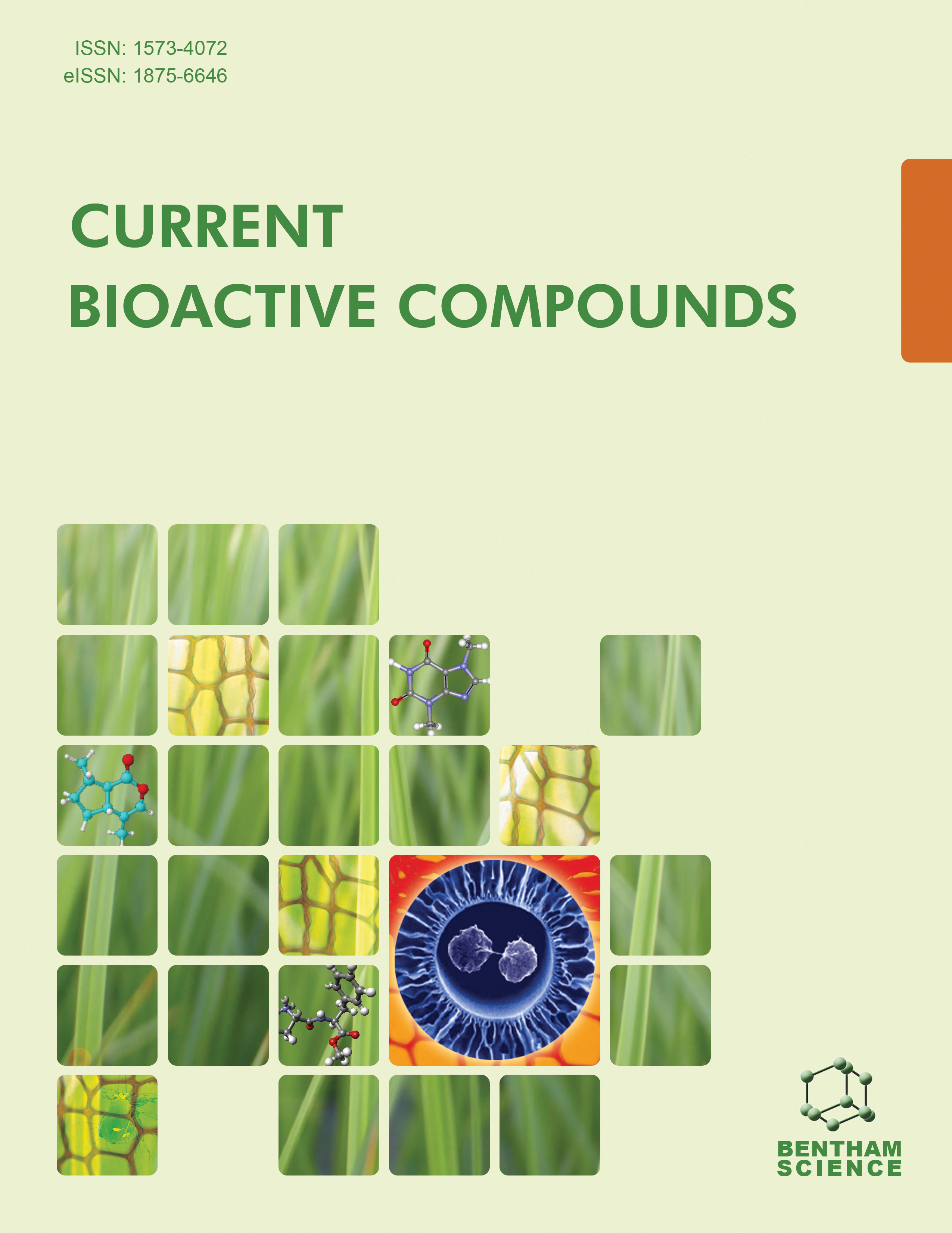- Home
- A-Z Publications
- Current Bioactive Compounds
- Previous Issues
- Volume 13, Issue 3, 2017
Current Bioactive Compounds - Volume 13, Issue 3, 2017
Volume 13, Issue 3, 2017
-
-
Molecular Biological Roles of Ursolic Acid in the Treatment of Human Diseases
More LessAuthors: Ray Navina, Yulia G. Lee and Soo M. KimBackground: Plants and their products have been used to treat human diseases since time immemorial. Ursolic acid (UA), a pentacyclic triterpenoid found in a wide range of plants, possesses a plethora of biological traits, such as anti-inflammatory, anti-oxidative, and anti-cancer properties. Extensive research has been undertaken to elucidate the biological, pharmacological, and clinical roles of UA in the treatment of human Read More
-
-
-
Synthesis and Pharmacological Applications of Certain Quinoxaline Analogues: A Review
More LessAuthors: Sunisha K. Subran and Priyankar PairaBackground: Quinoxaline is versatile ring systems which possesses a wide range of physicochemical and biological activities. This heterocyclic nucleus is becoming an attractive target for extensive research due to its inherent diverse properties. Various efficient, mild and eco-friendly methods have been developed for the preparation of quinoxaline derivatives in high yields. Here, we have highlighted some convenient Read More
-
-
-
Structure-Based Drug Design, Molecular Dynamics and ADME/Tox to Investigate Protein Kinase Anti-Cancer Agents
More LessAuthors: Evelyn M.L.P.Diniz, Joao G.C. Poiani, Carlton A. Taft and Carlos H.T.P. da SilvaBackground: Analysis of different types of cancer such as breast, prostate and ovarian carcinomas have shown that protein kinase B is overexpressed, making this an important target in drug design studies. We use various models of structure-based drug design to investigate the PKB target screening half a million compound databases. Genetic algorithms and grid generation are the bases used in the docking proc Read More
-
-
-
Synthesis and Biological Evaluation of Triazole-Vanillin Molecular Hybrids as Anti-Cancer Agents
More LessBackground: Triazole based drugs are widely used in cancer patients for the treatment of lifethreatening invasive fungal infections. A recent report on the usefulness of 1,2, 3- triazole scaffold for the inhibition of tyrosine kinases stimulated our curiosity to design new molecules based on this moiety. Methods: A series of new heterocyclic compounds containing 1,2,3 triazole moiety tethered to substituted vanillin or isovanillin w Read More
-
-
-
Prospecting for New Inhibitors of Anaplastic Lymphoma Kinase, A Clinically Relevant Oncogenic Drug Target
More LessAuthors: Daniel F. Kawano, Carlton A. Taft and Carlos H.T.P. da SilvaBackground: Since the introduction of Gleevec in 2001, protein kinases have been explored as therapeutic targets for the treatment of several cancers. Specifically, anaplastic lymphoma kinase (ALK), a receptor tyrosine kinase belonging to the insulin receptor superfamily, plays an important role in anaplastic large-cell lymphomas (ALCLs) and non-small cell lung carcinomas (NSCLCs). The first inhibitor of ALK, Crizoti Read More
-
-
-
Synthesis and Molecular Modeling Studies of Novel 2,4-Disubstituted-1, 5-Diphenyl-1-H-Imidazole Derivatives as Potential Anti-Tubercular Agents
More LessAuthors: Ravindra D. Bendagude and Manish S. KondawarBackground: The present discussion reports the synthesis of a series of novel derivatives 2, 4-disubstituted -1, 5 -diphenyl substituted -1-H-imidazole derivatives and their molecular modeling studies as antitubercular agents. Methods: Various substituted aromatic aldehydes (0.01 mol) and anilines (0.01mol) reacted in the presence of methanol and glacial acetic acid into Schiff bases. Schiff bases were treated with TOS Read More
-
-
-
Extracellular Release of Non-Peptide Group Compounds by Antifungal Bacillus and Brevibacillus Strains
More LessAuthors: Amita Shrivastava, Mahendra K. Gupta, Pradeep K. Singhal and Pankaj ShrivastavaBackground: Emergence and reemergence of infectious diseases are major problems in public health and global economics. Due to selective pressure and widespread use of antifungal drugs, there have been increasing reports of antifungal resistance. Thus, new therapeutic drugs and/or approaches are needed to improve the management of these diseases and to overcome these problems. Our Bacillus and Brevibacillus Read More
-
-
-
Antiplasmodial Compounds from Leaves of Dodonaea angustifolia
More LessBackground: Dodonaea angustifolia is used in Ethiopian traditional medicine to treat malaria. The objective of this work was to conduct bioassay guided fractionation of the leaves of D. angustifolia using Plasmodium berghei infected mice. Method: The antiplasmodial activity of the extracts and pure compounds was evaluated using the standard Peter's four-day suppressive method. The structures of isolated compounds wer Read More
-
Volumes & issues
-
Volume 21 (2025)
-
Volume 20 (2024)
-
Volume 19 (2023)
-
Volume 18 (2022)
-
Volume 17 (2021)
-
Volume 16 (2020)
-
Volume 15 (2019)
-
Volume 14 (2018)
-
Volume 13 (2017)
-
Volume 12 (2016)
-
Volume 11 (2015)
-
Volume 10 (2014)
-
Volume 9 (2013)
-
Volume 8 (2012)
-
Volume 7 (2011)
-
Volume 6 (2010)
-
Volume 5 (2009)
-
Volume 4 (2008)
-
Volume 3 (2007)
-
Volume 2 (2006)
-
Volume 1 (2005)
Most Read This Month
Article
content/journals/cbc
Journal
10
5
false
en

Most Cited Most Cited RSS feed
-
-
Podophyllotoxin: Current Perspectives
Authors: Ying Qian Liu, Liu Yang and Xuan Tian
-
- More Less

